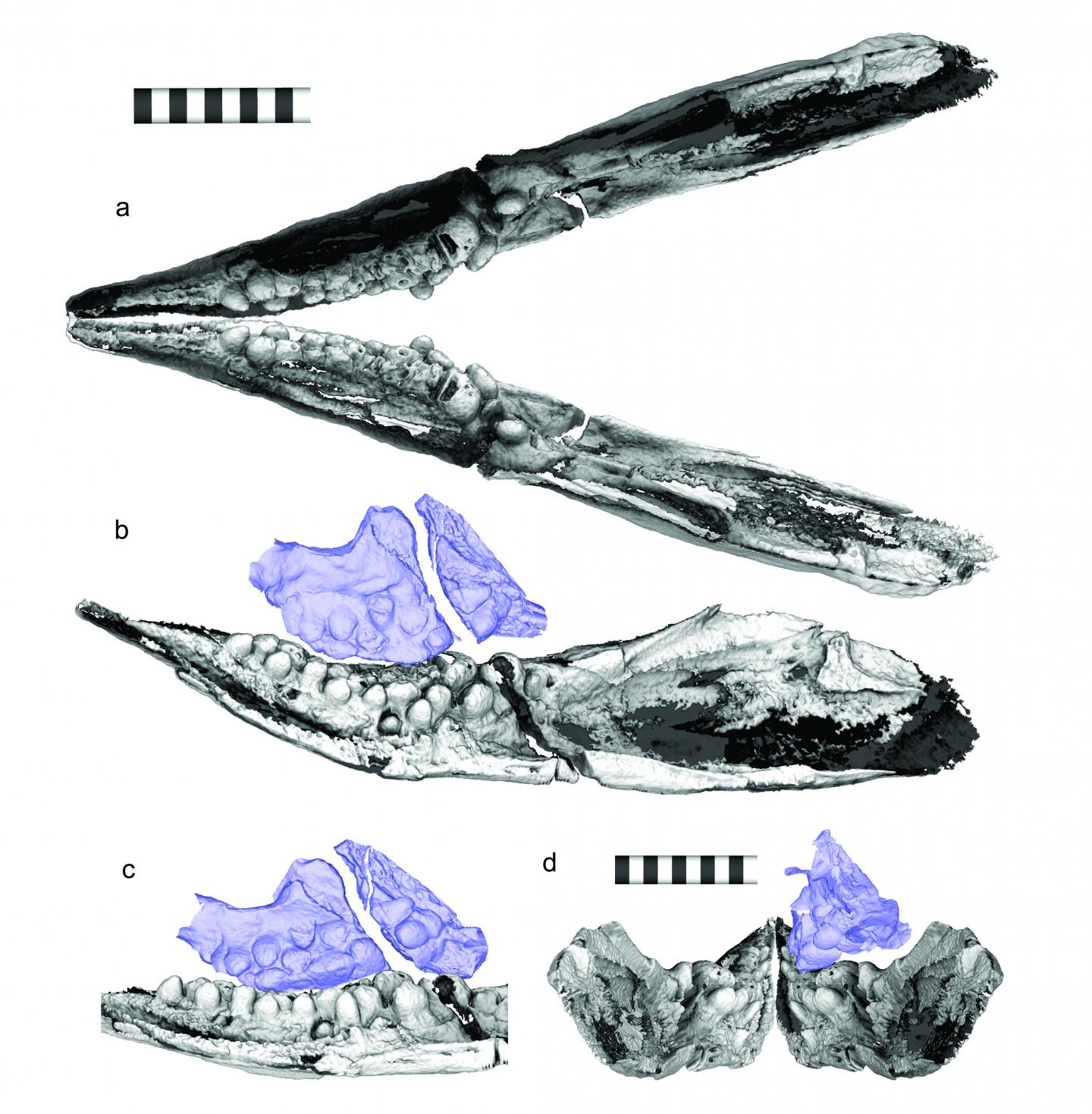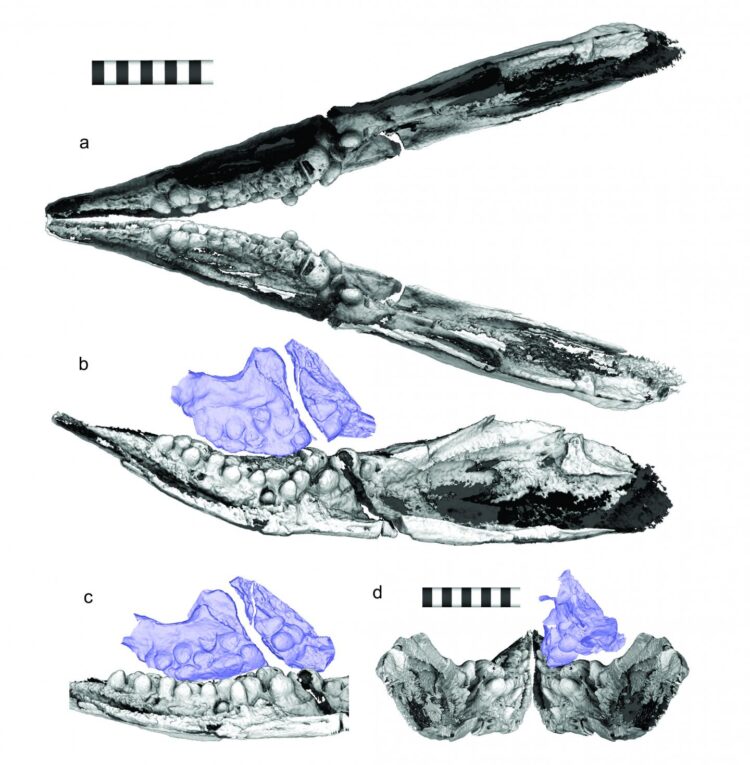CT scans of rounded teeth help explain how this order of marine reptiles took over the oceans

Credit: Ryosuke Motani et al.
As bad as things might seem here in 2020, they could be worse: we could be living 252 million years ago during the Permian mass extinction. Volcanic eruptions and dramatic, sudden climate change killed most of the animals on land and almost everything in the oceans, setting the stage for the later rise of the dinosaurs on land and an explosion of new marine life. One kind of marine reptile, the ichthyosaurs, eventually evolved into sleek, dolphin-like predators, but scientists don’t know much about early ichthyosaurs. But by CT-scanning the fossil of one of the first ichthyosaurs, scientists discovered pebble-shaped teeth hidden in its short snout. These strange teeth, probably used for crushing the shells of snails and clam-like bivalves, help illuminate the ways that early ichthyosaurs filled different roles in Triassic marine ecosystems.
“We don’t know exactly the ancestry of ichthyosaurs. They’re reptiles, and they’re probably archosaurs–that is to say, they’re more closely related to crocodiles and dinosaurs and birds than they are to lizards and snakes–but even that isn’t 100%,” says Olivier Rieppel, a paleontologist and Rowe Family Curator of Evolutionary Biology at Chicago’s Field Museum, who co-authored a new paper on the findings in Scientific Reports. “By studying this early ichthyosaur’s unusual rounded teeth, we get a better understanding of how these animals evolved and what their lifestyles were like.”
The paper focuses on Cartorhynchus lenticarpus, one of the earliest and smallest ichthyosaurs ever discovered. Later ichthyosaurs were dolphin-like, with long snouts full of sharp teeth and sleek, streamlined bodies for cutting through the water. But if those ichthyosaurs looked like murder dolphins, then Cartorhynchus was kind of a seal-tadpole. Its name means “short-snouted,” and its face matches its name. Cartorhynchus was only a little more than a foot long, and its flexible wrist joints suggest that it was able to come up out of the water and scoot around on land like a seal. “Ichthyosaurs became creatures of the open ocean, but the smaller species like Cartorhynchus probably lived closer to the shore and picked up invertebrates to eat from the sea floor,” says Rieppel.
This new study builds on the description of Cartorhynchus by several of the same scientists in 2014, including the new paper’s corresponding author, Ryosuke Motani of the University of California, Davis. “When we first described Cartorhynchus, we thought that it didn’t have any teeth at all and was a suction feeder. But later on, researchers realized that it did have some teeth further back in its jaws,” says Rieppel. “In this study, we took CT scans of the fossil to see the teeth that were hidden in its skull, and we found that they had an unusual pebble-like shape.”
These rounded teeth were in the back of the jaws, where our molars are, and were likely used to crush small hard-shelled invertebrates like snails and clam-like bivalves. The teeth also showed wear and tear suggesting that even though the only known specimen of Cartorhynchus was just over one foot long, it was full-grown.
Armed with this new knowledge about Cartorhynchus, the researchers compared it to other early ichthyosaurs. They found that rounded teeth cropped up in several other ichthyosaur species, suggesting that the trait evolved independently more than once, rather than all round-toothed ichthyosaurs evolving from one common round-toothed ancestor. Meanwhile, many other early ichthyosaurs had pointed cone-shaped teeth.
These different tooth shapes springing up in different families gives us a glimpse of the world in which ichthyosaurs were evolving. “There were no marine reptiles prior to the Triassic,” says Rieppel. “That’s what makes these early ichthyosaurs so interesting–they tell us about the recovery from the mass extinction, because they entered the sea only after it.” And, since most sea creatures died in the mass extinction, there was a lot of free real estate, evolutionarily speaking–lots of niches for new animals to fill. “After the mass extinction, the marine biota was nearly empty and ready to be recolonized,” Rieppel explains.
Animals’ teeth can tell us a lot about their lifestyles: what they were eating and how. The rapid emergence of lots of different kinds of ichthyosaurs with different kinds of teeth points to the way that they took over the oceans and played different ecological roles. It’s also likely that the repeated evolution of rounded crushing teeth in ichthyosaurs like Cartorhynchus and others was driven by the evolution of hard-shelled prey that became prevalent at this time.
“Fossils are clues about what the world was like long ago,” says Rieppel. “By gaining a better understanding of how these ichthyosaurs evolved, we get a better sense of how life rebounds after extinctions, and that lesson is still relevant today.”
###
This study was contributed to by researchers from Anhui Geological Museum, University of California, Davis, Peking University, Nanjing Institute of Geology and Palaeontology, Chinese Academy of Science, Università degli Studi di Milano, and the Field Museum.
Media Contact
Kate Golembiewski
[email protected]
Related Journal Article
http://dx.





